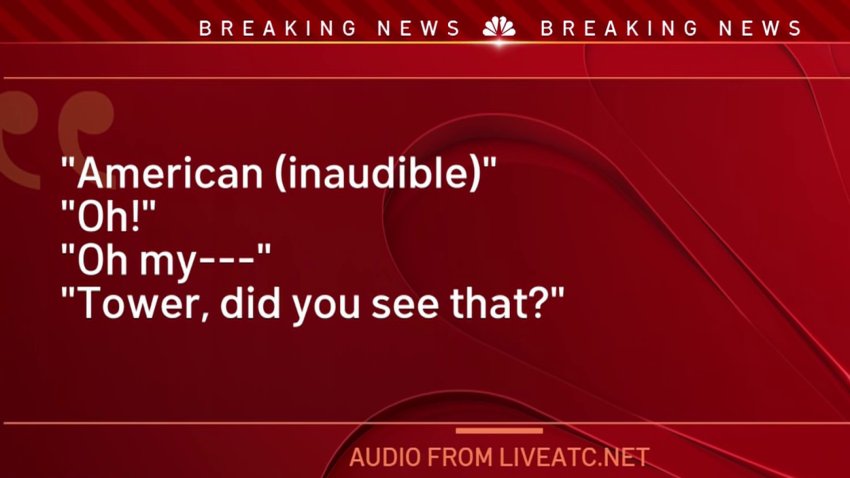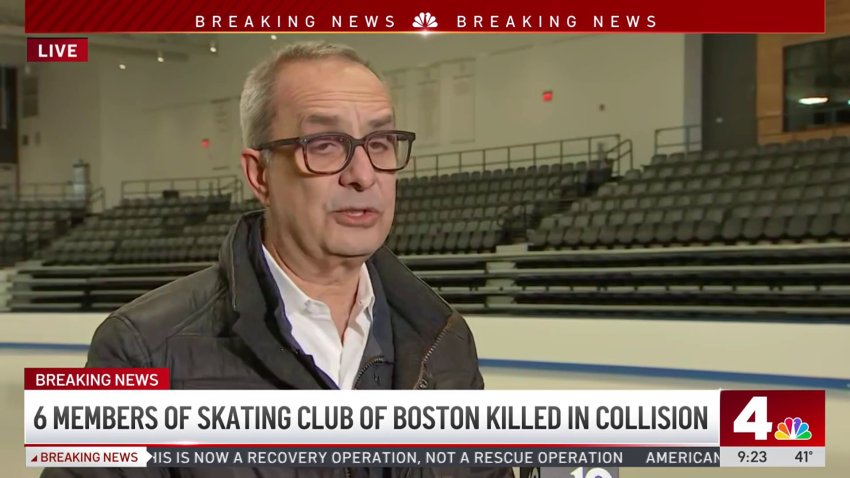You’re watching the NBC 5 Chicago News streaming channel, which plays local Chicago news 24 hours a day, seven days a week. You can find the “NBC 5 Chicago News” streaming channel on your phone or computer, and on Peacock, Samsung, Roku, Xumo or on our app, so you can watch our local news on your schedule.
Live updates on the crash can be found here.
As the nation reeled from the deadliest American aviation disaster in more than two decades, President Donald Trump on Thursday blamed diversity initiatives for undermining air safety and questioned the actions of a U.S. Army helicopter pilot involved in the midair collision with a commercial airliner.
As Trump spoke, a federal investigation into the crash was just getting started and first responders were still working to recover bodies from the wreckage of the commercial jet and army helicopter that crashed into the Potomac River near Reagan Washington National Airport.
The collision occurred Wednesday evening in one of the world's most tightly controlled airspaces, just over 3 miles south of the White House and the U.S. Capitol. A massive search-and-rescue effort launched overnight turned into a recovery operation by mid-Thursday morning.
Here's what Trump said about the crash and what we know so far about the investigation:
What did Trump say about the plane crash?
“As one nation, we grieve for every precious soul that has been taken from us so suddenly,” Trump said at a press briefing Thursday.
“Sadly, there are no survivors” of the crash, he said.
Trump said it was still not clear what led to the crash. He said the U.S. military and the National Transportation Safety Board are investigating.
“We’ll find out how this disaster occurred and will ensure that nothing like this ever happens again," he said.
Feeling out of the loop? We'll catch you up on the Chicago news you need to know. Sign up for the weekly Chicago Catch-Up newsletter.
Trump questions pilots and air traffic control, blames DEI initiatives
Speaking from the White House, Trump at points acknowledged that it was too soon to draw conclusions, but he moved nonetheless to assign blame.
“The FAA is actively recruiting workers who suffer severe intellectual disabilities, psychiatric problems and other mental and physical conditions under a diversity and inclusion hiring initiative spelled out on the agency’s website,” Trump said. He added that the program allowed for the hiring of people with hearing and vision issues as well as paralysis, epilepsy and “dwarfism.”
Trump said air traffic controllers needed to be geniuses.
“They have to be talented, naturally talented geniuses,” he said. “You can’t have regular people doing their job.”
Trump said he had no evidence to support his claims that diversity, equity and inclusion initiatives and hiring preferences played a role in the crash, allowing that "it just could have been.” He defended doing so “because I have common sense.”
Trump said “we do not know what led to this crash but we have some very strong opinions.” Then he proceeded to discuss what happened, at one point wondering if the helicopter pilot was wearing night vision goggles.
Trump was asked repeatedly to explain why he was blaming federal diversity and inclusion promotion efforts for the crash, at one point alleging that previous leadership had determined that the FAA workforce was “too white.” He did not back up those claims, while also declaring it was still not clear the FAA or air traffic controllers were responsible for the crash.
Trump said “you had a pilot problem” and the helicopter was “going at an angle that was unbelievably bad.” And he questioned why the Army pilot didn’t change course, saying that “you can stop a helicopter very quickly.” He also mused about the air traffic controller, saying of the two aircraft, “for whatever reason they were at the same elevation," adding "they should have been at a different height.”
At one point, Trump was challenged on his claim that the FAA, under Democratic presidents, had promoted the hiring of people with disabilities. The fact-checking website Snopes found that the policy Trump referenced has existed for a decade, including his first term.
Trump complained specifically about Pete Buttigieg, who served as transportation secretary under former President Joe Biden, calling him “a disaster.”
“He’s run it right into the ground with his diversity,” Trump said.
Complaining about the previous administration, Trump continued, “their policy was horrible and their politics was even worse.”

Buttigieg responded in a post on X, calling Trump's comments “despicable.” He added: “As families grieve, Trump should be leading, not lying."
Trump made a point to tell Transportation Secretary Sean Duffy, who was sworn in on Tuesday as Buttigieg's replacement, “It’s not your fault.” Duffy took the White House podium alongside Trump and declared, “When Americans take off in airplanes, they should expect to land at their destination.” Duffy added, “We will not accept excuses.”
Despite the crash, Trump said he "would not hesitate to fly.”
What happened in the crash?
The collision involved a regional jet out of Wichita, Kansas, that was preparing to land and a military helicopter that was on a training exercise, according to the Federal Aviation Administration.
A few minutes before the jet was to land, air traffic controllers asked American Airlines Flight 5342 if it could do so on a shorter runway, and the pilots agreed. Controllers cleared the jet to land and flight tracking sites showed the plane adjust its approach to the new runway.
Less than 30 seconds before the collision, an air traffic controller asked a helicopter if it had the arriving plane in sight. The controller made another radio call to the helicopter moments later, saying “PAT 25 pass behind the CRJ" — apparently telling the copter to wait for the Bombardier CRJ-701 twin-engine jet to pass. There was no reply. Seconds after that, the aircraft collided.
The plane’s radio transponder stopped transmitting about 2,400 feet short of the runway, roughly over the middle of the Potomac.
The body of the plane was found upside-down in three sections in waist-deep water, officials said. The helicopter's wreckage was also found.
What did video show?
A grainy snippet of video footage taken in the dark of night, seemingly by an airport CCTV camera, appears to show the fatal mid-air collision.
In the first moments of the video footage, nothing seems untoward. It shows scenes one would expect from any bustling airport — including another passenger aircraft taxiing in the foreground.
A bright light flashing cherry red atop that plane's fuselage as it maneuvered carefully past a retractable gangway was the only dash of color in the otherwise largely monochrome picture — before the angry fireball that subsequently punctures the night sky.

In the video's next second: the unexpected. A flickering dot of light appears from the left of the frame, at first so faint that it might be mistaken for a distant star.
But it is moving. Quickly, too. The dot appears to be the Army UH-60 Blackhawk helicopter, on a training exercise with a crew of three soldiers aboard.
The tiny smudge of light from the helicopter speeds ever-closer to the AA flight, but then flickers off and disappears for a tiny fraction of a second. Has it sensed danger and veered off the collision course?
The next moment brings the fateful answer: Unfortunately, no.
The helicopter light-dot reappears, still racing toward the larger bright white of the passenger plane.
Then, an explosion — a spreading fireball of yellow and orange that suddenly flares in the darkness like an unnatural sun before starting to fade.
Where, just milliseconds earlier, there had been only two moving lights in the sky — the plane's and the helicopter's — now there are many: debris scattering and tumbling through the darkness.
In the foreground, the other untouched passenger plane still trundles on, seemingly unaware as what appears to be the largest chunk of wreckage is falling fast and uncontrolled behind it.
The aircraft plummeted into the Potomac River, where the fuselage was found upside down in three sections in waist-deep water, officials said.
Who was on the plane?
The collision was the deadliest U.S. air crash in nearly 24 years. At least 28 bodies have been pulled from the icy waters.
Among the passengers were members of the Skating Club of Boston who were returning from the 2025 U.S. Figure Skating Championships in Wichita. They included teenage figure skaters Jinna Han and Spencer Lane, the teens' mothers and two highly regarded Russian-born coaches, Evgenia Shishkova and Vadim Naumov, who won a 1994 world championship in pairs skating.
Other Russians were also on the jet, according to the Kremlin.

Skating Club of Boston CEO Doug Zeghibe said Thursday that a total of 14 of the crash victims were coming back from a national development camp for promising young skaters following the U.S. Championships.
The three soldiers aboard the helicopter were doing an annual night proficiency training flight, Defense Secretary Pete Hegseth said.
The crew was “very experienced” and were not new to the unit or the congested flying that occurs daily around Washington, D.C. That is according to Jonathan Koziol, chief of staff for Army aviation.
“Both pilots had flown this specific route before, at night. This wasn’t something new to either one of them,” Koziol said. “Even the crew chief in the back has been in the unit for a very long time, very familiar with the area, very familiar with the routing structure.”
The crew included an instructor pilot and pilot in command were experienced to the point where either crew member “could manage that helicopter by themselves.”
Their names had not been released as officials were notifying relatives. Their bodies were were among those recovered, according to U.S. officials who spoke on the condition of anonymity to discuss details that hadn't been announced yet.
What do we know about the investigation?
NTSB holds first briefing
National Transportation Safety Board Chair Jennifer Homendy said Thursday at a press conference that “we look at facts on our investigation and that will take some time.”
She was responding to a question on speculation about the cause of the crash.
Homendy also said the black boxes from the aircraft have not been recovered yet.
Attorney says airport's crowded space is well-known fact
The crowded airspace around the airport was well known before the crash, said Robert Clifford, an aviation attorney from Chicago involved in numerous airline disaster cases.
“I can’t get over how stunningly clear it is that this was a preventable crash and this should never, ever have occurred,” Clifford told The Associated Press.
“There have been discussions for some time about the congestion associated with that and the potential for disaster. And we saw it come home last night,” Clifford said.
He said the Ronald Reagan Washington National Airport was “very unique" as it is not only located near the nation's capital but also is a highly restricted space.
“However, because of the massive military presence in our capital, the Pentagon and a number of bases, there’s understandably a lot of military aircraft in the area.”
Report says staffing in control tower was 'not normal' at time of deadly air collision
A report by the Federal Aviation Administration says staffing in the air traffic control tower was “not normal” at time of the midair collision near Washington.
The report was obtained Thursday by The Associated Press.

